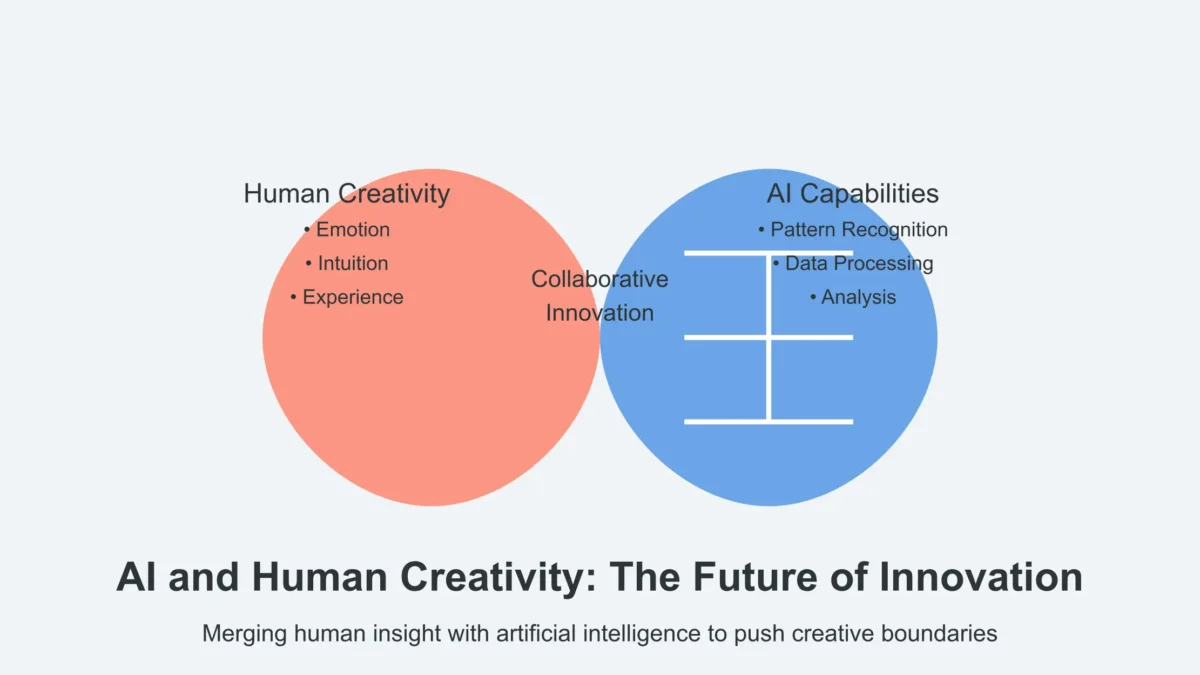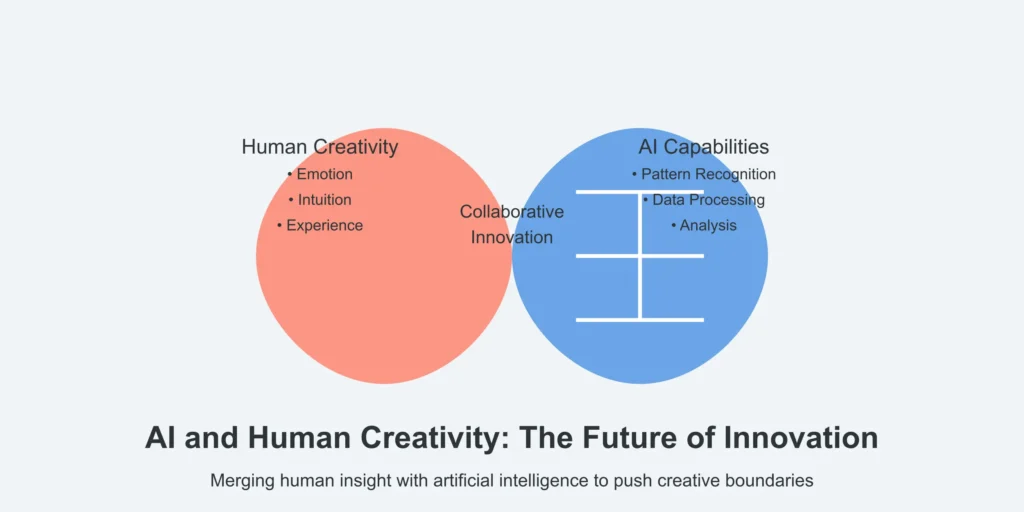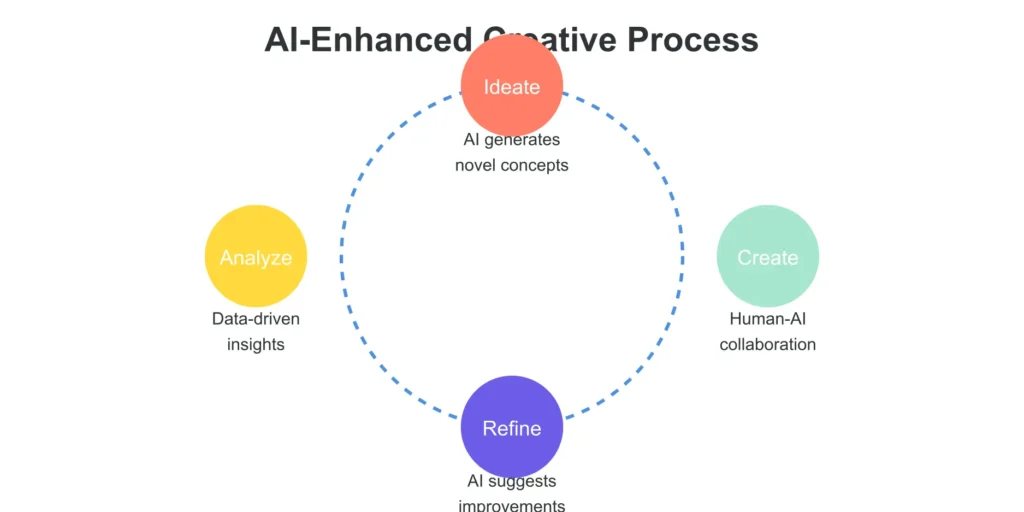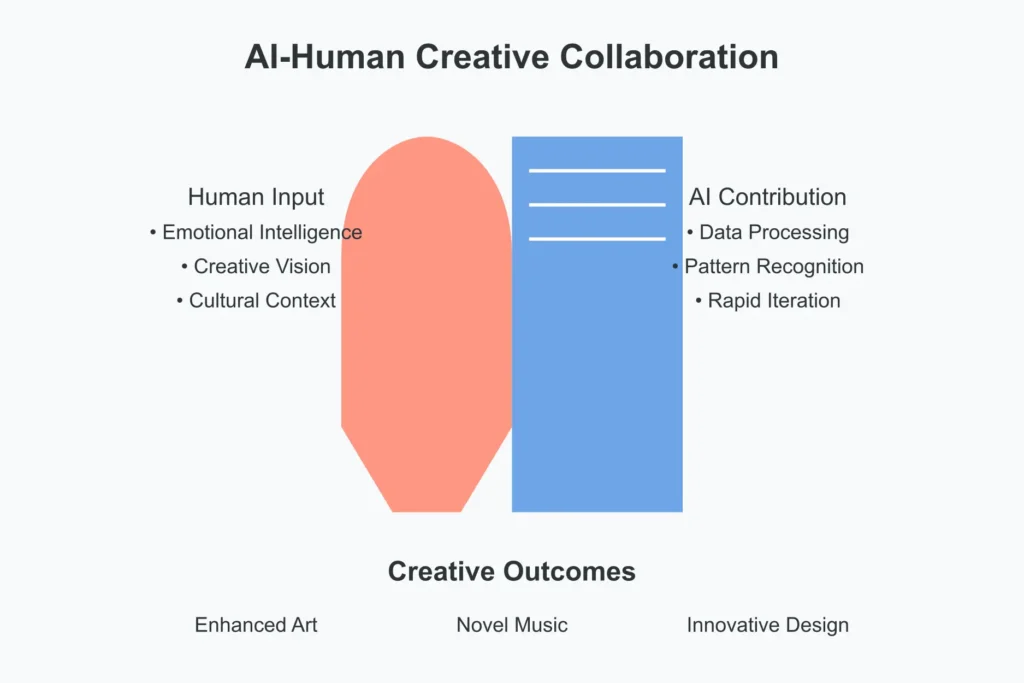
AI and Human Creativity: A New Era of Innovation

In the rapidly evolving technological landscape of 2025, the fusion of AI and human creativity has become a focal point of discussion. As AI systems increasingly undertake tasks traditionally reserved for human ingenuity, questions arise: Can AI and human creativity merge to produce truly original work, or are machines merely mimicking human outputs? This article delves into the nuances of AI and human creativity, exploring their intersections, distinctions, and the potential for collaboration.
Key Highlights: AI and Human Creativity
- Defining Creativity: Understanding the essence of creativity and how it manifests in humans versus machines.
- AI’s Role in Creative Processes: Examining areas where AI and human creativity intersect and how AI enhances the creative process.
- Limitations of AI Creativity: Identifying the boundaries of AI’s creative capabilities in comparison to human innovation.
- Collaborative Potential: Exploring how AI and human creativity can synergize to enhance innovation.
You can also read our previous articles on DeepSeek’s AI Power, China’s AI shocks the Tech World, and the Best Data Visualization Tools for 2025.
Defining Creativity: AI and Human creativity
Creativity is often defined as the ability to generate ideas or artifacts that are both novel and valuable. Human creativity stems from a complex interplay of experiences, emotions, and cognitive processes, allowing individuals to produce original works infused with personal meaning and cultural context.
In contrast, AI and human creativity differ significantly in their approach: AI-driven creativity relies on algorithms processing vast datasets to identify patterns and generate outputs. While these outputs can mimic human-like creativity, they lack the intrinsic emotional depth and subjective experiences that characterize true human innovation.
AI’s Role in Creative Processes

AI and human creativity intersect in several exciting ways, particularly in fields traditionally dominated by human creativity:
- Art and Design: AI algorithms can generate visual art, design logos, and even create intricate patterns, offering fresh perspectives and accelerating the creative process. For instance, Istanbul-born artist Refik Anadol utilizes AI to create immersive digital sculptures derived from vast datasets, such as 3D scans of the Amazon rainforest and millions of images of flora and fauna. His work emphasizes the potential of AI and human creativity to transform raw data into captivating visual experiences.
- Music Composition: AI and human creativity come together in music composition as AI systems are capable of generating music in various styles. Platforms like Amper Music and AIVA enable musicians to compose symphonies, soundtracks, or jingles, enhancing the process with novel motifs and harmonies, which might have been outside their initial creative vision.
- Literature and Content Creation: Tools like OpenAI’s GPT models are reshaping content creation. By analyzing vast text corpora, these AI-driven platforms help writers overcome creative blocks, suggesting new directions for articles, stories, or poems. While AI and human creativity collaborate in this domain, the emotional resonance and intentionality of the content still rely heavily on human input.
These applications highlight how AI and human creativity can collaborate to achieve results that neither could achieve independently.
Limitations of AI Creativity
Despite its advancements, AI and human creativity are not without their distinctions and limitations:
- Lack of Emotional Understanding: AI lacks consciousness and cannot experience emotions, making it challenging for machines to create works that authentically resonate on an emotional level. While AI can analyze emotional patterns in data, it does not possess the subjective experience necessary to imbue creations with genuine emotional depth.
- Dependence on Existing Data: AI generates outputs based on the data it has been trained on, which can lead to a lack of true originality. This reliance on data can reinforce existing biases or replicate existing styles, as AI and human creativity often struggle to break entirely from these constraints.
- Absence of Intentionality: While AI can produce art or music, it does so without purpose or intent, distinguishing it from human creativity that is deeply embedded with meaning, context, and message. The lack of intentionality means AI-generated works may lack the nuanced messages that human creators consciously incorporate into their art.
Collaborative Potential: Merging AI and Human Creativity

Rather than viewing AI as a competitor, AI and human creativity can be seen as collaborators that enhance each other’s potential:
- Idea Generation: AI can analyze vast datasets to suggest novel combinations and concepts, serving as a catalyst for human inspiration. AI-driven platforms can propose unique design elements or narrative structures that artists and writers might not have considered, expanding the creative horizon of AI and human creativity.
- Efficiency in Repetitive Tasks: By automating routine aspects of the creative process, AI allows human creators to focus more on conceptualization and refinement. In industries like fashion, brands such as Mango use AI-generated models for advertising, allowing designers to concentrate on innovation and aesthetics while still engaging AI and human creativity in new ways.
- Personalization: AI and human creativity intersect powerfully in personalization. AI can tailor creative content to individual preferences, enabling more personalized artistic experiences. Streaming platforms like Spotify employ AI algorithms to analyze user listening habits, creating customized playlists that enhance user engagement through personalized content.
This symbiotic relationship between AI and human creativity leads to innovative outcomes that neither could achieve alone.
Case Studies of AI and Human Collaboration
Several real-world examples illustrate the successful integration of AI and human creativity:
- Perfume Creation: The fragrance industry has begun incorporating AI to develop new scents. AI tools analyze vast databases of fragrance formulas and consumer preferences, suggesting novel combinations. However, the final approval and nuanced adjustments rely on the expertise of human perfumers, ensuring the artistic integrity of the scent while blending AI and human creativity.
- Film Production: In the movie The Brutalist, AI technology was employed to refine actors’ dialogue, enhancing linguistic authenticity. Director Brady Corbet used AI software to adjust the accents of actors Adrien Brody and Felicity Jones, ensuring that the performances resonated with the intended cultural context. This collaboration between AI and human creativity allowed for more nuanced and precise production choices.
Conclusion
The debate over whether AI can truly be creative continues, but one thing is clear: AI is transforming the creative landscape. While machines lack emotional depth, lived experiences, and intentionality, they excel at pattern recognition, data processing, and idea generation. Rather than replacing human creativity, AI serves as a powerful tool that enhances and accelerates artistic and intellectual pursuits. The future of creativity lies in collaboration, where AI and human creativity amplify each other to create groundbreaking works that neither could achieve independently.
Frequently Asked Questions (FAQ)
- Can AI ever truly replace human creativity?
AI can assist and enhance human creativity but cannot replace it entirely. Human experiences, emotions, and intuition play a crucial role in the creative process—elements that AI currently lacks. - How is AI being used in creative industries?
AI and human creativity are transforming various creative fields, including visual arts, music composition, literature, and film production. AI helps artists generate ideas, automate repetitive tasks, and personalize content for audiences. - What are the ethical concerns of AI-generated creativity?
Ethical concerns include originality, copyright issues, bias in training data, and the potential loss of human jobs in creative sectors. Ensuring responsible AI usage and maintaining human oversight are crucial. - Will AI-generated content always be distinguishable from human-created works?
As AI technology advances, it becomes increasingly difficult to distinguish AI-generated content from human-created works. However, elements such as emotional depth and intentional storytelling often set human creations apart. - How can creators leverage AI without losing their artistic integrity?
Creators can use AI as a tool to enhance their work rather than replace their creative processes. By integrating AI for idea generation, efficiency, and personalization while maintaining human oversight, artists can ensure their work remains authentic and original.
